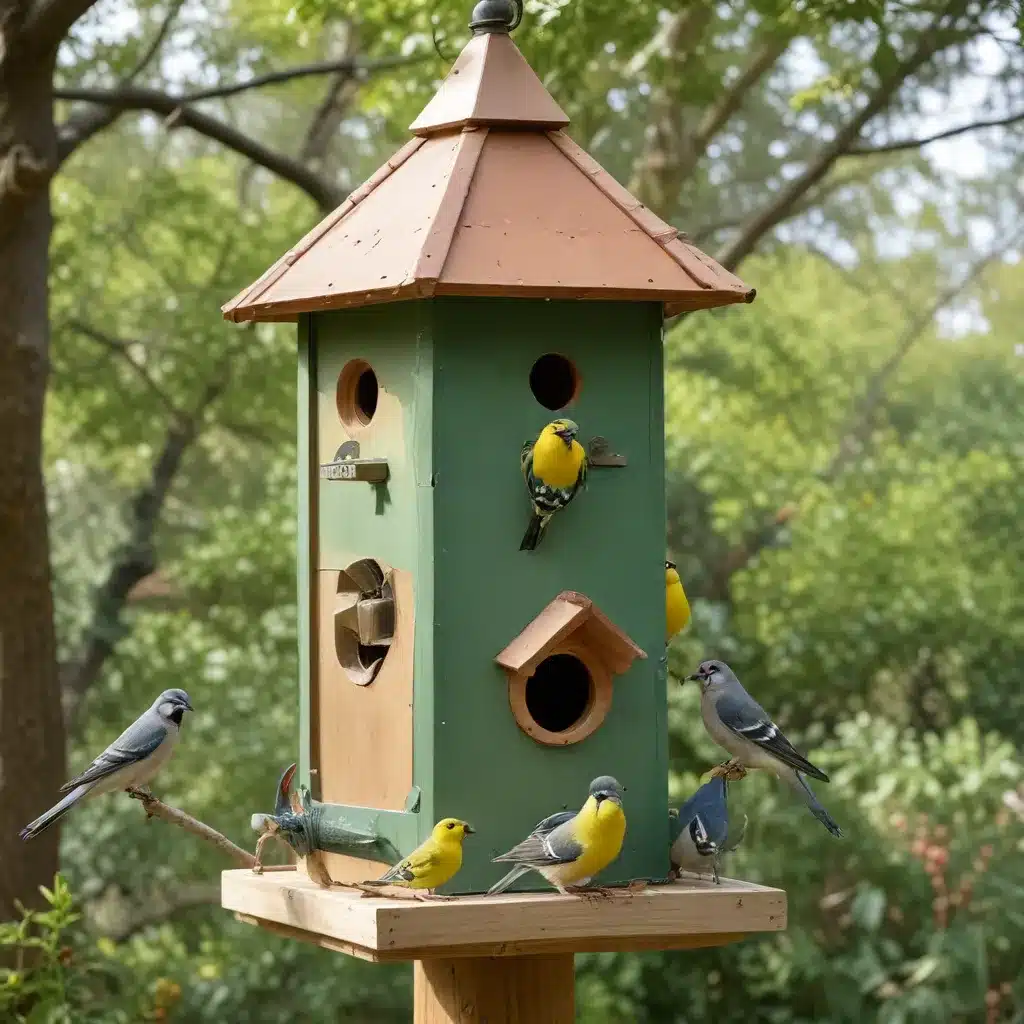
As an experienced avian caretaker and expert in bird species, breeding, care, habitat setup, nutrition, health, training, exotic species management, behavior interpretation, adoption practices, enrichment techniques, safety protocols, seasonal care, FAQs, customer testimonials, bird rescue, product assessments, travel advice, debunking myths, and events/news in the avian community, I’m excited to share my knowledge to help you create the ultimate backyard paradise for your feathered friends.
Avian Habitat Design
Designing a safe, enriching, and visually stunning outdoor aviary for your birds requires careful consideration of their unique needs and natural behaviors. Let’s dive into the key elements to keep in mind.
Birdhouse Considerations
The birdhouses or nest boxes you provide serve as crucial shelters, nesting sites, and roosting spots for your avian residents. Choose sturdy, weather-resistant materials like cedar or redwood that are easy to clean and maintain. Ensure proper ventilation, drainage, and entry/exit points sized appropriately for your bird species. Placement is also critical – locate birdhouses in quiet, secure areas with ample shade and protection from predators and harsh weather.
Perch Placement
Perches are a fundamental part of any aviary, allowing birds to comfortably rest, observe their surroundings, and exercise their natural climbing and balancing skills. Incorporate a diverse array of perch types, textures, and heights to cater to individual preferences. Natural branches, ropes, and artificial perches of varying diameters will encourage foot health and exercise. Strategically position perches near food/water stations, nest boxes, and enrichment items.
Vegetation Selection
Lush, varied greenery is essential for creating a stimulating, naturalistic environment. Choose a mix of hardy, non-toxic plant species that provide shelter, nesting materials, and foraging opportunities. Incorporate a combination of towering trees, dense shrubs, and trailing vines to mimic the layered canopies birds experience in the wild. Rotate new plants seasonally to maintain visual interest and cater to changing needs.
Avian Enrichment Strategies
Keeping your feathered friends mentally and physically stimulated is crucial for their overall well-being. Incorporate a diverse array of enrichment elements to encourage natural behaviors and prevent boredom.
Foraging Opportunities
Offer a variety of foraging feeders, puzzles, and hidden treats to spark your birds’ natural food-seeking instincts. Scatter whole nuts, seeds, and fresh produce throughout the aviary, hiding them in crevices and hanging them from branches. Rotate novel food items and presentation methods to maintain interest and challenge their problem-solving skills.
Nesting Amenities
Provide an array of nesting materials like shredded paper, hay, straw, and cotton fibers for birds to build their ideal homes. Include shallow bowls or baskets near perches and sheltered areas to encourage natural nesting behaviors. Regularly replenish these materials to keep things fresh.
Environmental Complexity
Amp up the visual and tactile complexity of the aviary with a variety of texture-rich elements. Hang swings, ladders, and mirrors at different heights. Scatter chewable toys, bells, and other engaging objects throughout the space. Rotating new items and rearranging the layout will keep your birds curious and active.
Bird Health and Safety
Ensuring the health, safety, and comfort of your avian residents is of the utmost importance. Implement robust precautions and protocols to protect them from potential threats.
Predator Protection
Safeguard your birds from wild predators by enclosing the aviary with sturdy, secure fencing or mesh that extends underground to prevent digging entry. Install deterrents like motion-sensor lights and alarms. Strategically place hiding spots, perches, and dense vegetation to give birds places to take cover.
Climate Control
Provide ample shade, ventilation, and temperature regulation to keep your birds comfortable in all weather conditions. Use a combination of natural and artificial shade structures. Ensure adequate airflow with fans or vents. Install heating and cooling systems as needed to maintain an ideal temperature range.
Sanitation Practices
Develop a thorough cleaning routine to maintain optimal hygiene and prevent the spread of illness. Regularly disinfect all surfaces, perches, and feeders. Scoop droppings daily and replace substrate as needed. Quarantine new birds, monitor for signs of illness, and work closely with an avian veterinarian.
Aviary Construction
Thoughtful planning and execution are essential when building a safe, functional, and visually appealing outdoor aviary for your feathered friends.
Structural Components
The foundation and framing of your aviary should be constructed from sturdy, weather-resistant materials like galvanized steel, aluminum, or pressure-treated wood. Secure the enclosure to the ground with concrete footings or anchors. Enclose the top and sides with high-quality mesh or wire fencing that is escape-proof and predator-proof.
Enclosure Dimensions
Ensure your aviary provides ample space for your birds to freely move, fly, and exercise. As a general guideline, allow a minimum of 6 cubic feet per small parrot, 12 cubic feet per medium parrot, and 24 cubic feet per large parrot. Adjust dimensions based on the number and size of your bird residents.
Access and Ventilation
Incorporate multiple access points, such as doors and sliding panels, to allow easy entry and exit for maintenance, cleaning, and bird management. Proper airflow is crucial – include vents, windows, and/or fans to ensure adequate ventilation and temperature regulation throughout the enclosure.
By prioritizing your birds’ unique needs, you can create an outdoor aviary that provides a safe, stimulating, and naturalistic environment for them to thrive. Remember to stay up-to-date on the latest avian care research, consult with avian veterinarians and experienced owners, and continuously monitor and adapt your aviary setup to ensure the optimal health and happiness of your feathered flock. For more expert tips and resources, be sure to visit Mika Birds Farm – your one-stop-shop for all things avian!


